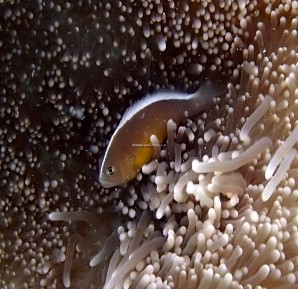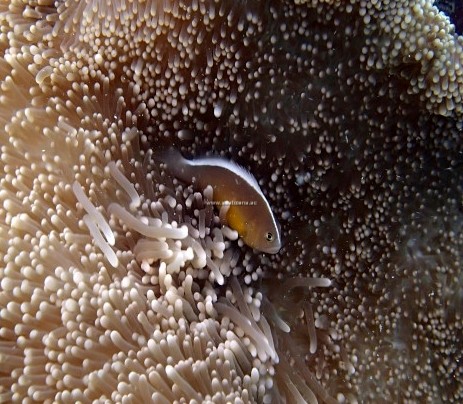Description:
Dorsal spines: 8-9; Dorsal rays: 17-20; Anal spines: 2; Anal rays: 12-14.
Light orange coloured clownfish, with a single, narrow, white stripe running from the mouth to the caudal peduncle.
Size:
Maturity: Unknown. Max length: 11.0 cm SL.
Habitat and Ecology:
Found in shallow inshore reef habitats, often in strong current zones (depth 1-25m). Protandrous hermaphrodites. Each pair is monogamous. This species is a commensal
inhabitant of sea anemones (Heteractis magnifica and Stichodactyla mertensii). Each anemone is home to a large female, a smaller functional male and several stunted juveniles; with the removal of the female, the male changes
sex and the largest of the juveniles develops into a functional male. Eggs are demersal and adhere to the substrate. Males guard and aerate the eggs.
Studies have shown that it is the female that defends the anemone using sound production, as well as a physical charge when other fishes attempt to enter. A. akallopisos
exhibit three different types of sounds, pops, short chirps, and long chirps, used depending on the type and duration of the encounter.
Fishery Status:
This species is not protected or subject to fishery regulations. It is not subject to current fishing methods.
Notes:
Photos. Courtesy and (c) 2021 of GVI/SPGA.
References:
Froese, R. & D. Pauly. Eds. (2022). FishBase. https://www.fishbase.se/summary/Amphiprion-akallopisos.html (19/06/22).
iNaturalistUK. Skunk Anemonefish (Amphiprion akallopisos). https://uk.inaturalist.org/taxa/154702-Amphiprion-akallopisos (19/06/22).
Myers, R. et al. (2017). Amphiprion akallopisos. The IUCN Red List 2017: e.T188538A1889747. https://dx.doi.org/10.2305/IUCN.UK.2017-2.RLTS.T188538A1889747.en. (19/06/22).
Citation:
Nevill, J.E.G. (2022). Amphiprion akallopisos, Skunk clownfish. Seychelles Seatizens. www.seatizens.sc. https://seatizens.sc/species/amphiprion-akallopisos-bleeker-1853/



pin up kazino: pin-up oyunu – pin up azerbaycan yukle
pin-up 141 https://azerbaijancuisine.com/# pin-up casino giris
pin-up
mexican drugstore online northern doctors mexican drugstore online
mexico pharmacy: mexican pharmacy northern doctors – mexico drug stores pharmacies
http://northern-doctors.org/# mexico pharmacies prescription drugs
п»їbest mexican online pharmacies: mexican pharmacy northern doctors – best online pharmacies in mexico
mexican border pharmacies shipping to usa mexican pharmacy online mexican rx online
https://northern-doctors.org/# п»їbest mexican online pharmacies
mexican border pharmacies shipping to usa: Mexico pharmacy that ship to usa – buying prescription drugs in mexico online
https://northern-doctors.org/# buying from online mexican pharmacy
buying prescription drugs in mexico mexican pharmacy mexican online pharmacies prescription drugs
mexico pharmacies prescription drugs: mexican pharmacy – mexican pharmacy
https://northern-doctors.org/# buying from online mexican pharmacy
mexico pharmacies prescription drugs: mexican pharmacy online – mexican mail order pharmacies
mexican drugstore online northern doctors pharmacy mexico drug stores pharmacies
buying prescription drugs in mexico online: Mexico pharmacy that ship to usa – medication from mexico pharmacy
purple pharmacy mexico price list: mexican pharmacy – mexico drug stores pharmacies
mexico drug stores pharmacies: mexico drug stores pharmacies – mexican pharmaceuticals online
medication from mexico pharmacy northern doctors pharmacy pharmacies in mexico that ship to usa
mexico pharmacy: Mexico pharmacy that ship to usa – mexico drug stores pharmacies
Insightful read! I found your perspective very engaging. For more information, visit: READ MORE. Eager to see what others have to say!
buying prescription drugs in mexico online northern doctors pharmacy medicine in mexico pharmacies
https://foruspharma.com/# medication from mexico pharmacy
buy prescription drugs from india: pharmacy website india – buy medicines online in india
top 10 online pharmacy in india: reputable indian pharmacies – india pharmacy mail order
india pharmacy mail order reputable indian online pharmacy indian pharmacy paypal
canadian pharmacy review: canadian pharmacy ratings – canada pharmacy reviews
https://foruspharma.com/# mexican mail order pharmacies
Online medicine home delivery: cheapest online pharmacy india – reputable indian pharmacies
adderall canadian pharmacy canadian pharmacies online buy canadian drugs
Online medicine order: indian pharmacies safe – best india pharmacy
canada pharmacy 24h: the canadian drugstore – canadian pharmacy 24
https://indiapharmast.com/# top 10 pharmacies in india
indian pharmacies safe: world pharmacy india – best online pharmacy india
safe reliable canadian pharmacy legitimate canadian pharmacy online reliable canadian pharmacy
http://paxloviddelivery.pro/# paxlovid covid
paxlovid price: paxlovid pharmacy – paxlovid for sale
http://doxycyclinedelivery.pro/# doxycycline capsules india
http://doxycyclinedelivery.pro/# doxycycline tab india
cost generic clomid pills: cost generic clomid without insurance – get cheap clomid
can i get cheap clomid no prescription: where can i buy clomid without rx – can i purchase clomid without prescription
https://paxloviddelivery.pro/# paxlovid buy
https://doxycyclinedelivery.pro/# doxycycline 20 mg india
ciprofloxacin mail online: buy cipro online – cipro for sale
http://clomiddelivery.pro/# can i get generic clomid without insurance
https://ciprodelivery.pro/# buy ciprofloxacin over the counter
amoxicillin 500mg for sale uk: amoxicillin 500mg capsule cost – buy amoxicillin from canada
http://clomiddelivery.pro/# where can i buy cheap clomid without prescription
can i get generic clomid without prescription: where to get clomid without dr prescription – can i buy clomid prices
can i buy cheap clomid tablets: how to buy clomid without dr prescription – where can i buy cheap clomid price